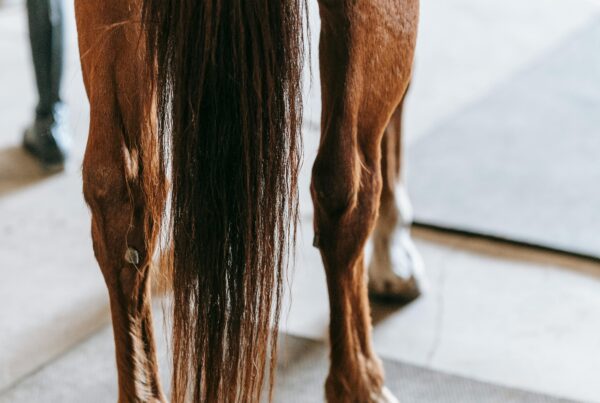As winter approaches, we have started to see the green pastures of summer replaced with muddy, waterlogged fields. Horse owners know all too well the challenges that come with managing horses in the wetter months of the year. There probably aren’t too many of us singing “mud, mud, glorious mud” as we tend to our horses! One condition that we, as veterinary surgeons, see more commonly in these months is pastern dermatitis, also known as mud fever.
What is mud fever?
Mud fever is one of the names given to a collection of conditions termed Pastern Dermatitis. Other names used are greasy heels or scratches. It primarily affects the lower limbs, but is not always limited to the pastern. It is typically characterised by swelling, heat, and pain in the limb, which is usually accompanied by discharge, leading to scabbing and crusting. It is almost always painful, and some horses can present with severe, rapid onset lameness of the affected limbs. It is more commonly seen in white legs and those with heavy feathering.
As the name suggests, the disease can be associated with wet, muddy conditions, but this is not always the case. Other causes can include bacterial infection, typically Staphylococcus species, fungal infection or infestation with Chorioptes leg mites or Neotrombicula autumnalis (harvest mites). In addition to these, photosensitisation secondary to contact with toxic plants, such as St John’s Wort, or liver disease, as well as autoimmune conditions, can lead to the development of pastern dermatitis. The reason we see the condition more frequently in winter is that chronic wetting of the skin may lead to abrasions or trauma, which facilitates the development of infection. So, mud does not cause the disease, but it does help it to develop.
What should you do if you suspect your horse has pastern dermatitis?
It is always important to check your horse’s legs at least once daily, particularly during the winter months. If you see any signs of swelling, heat, pain or crusting, it is important to seek advice from the veterinary practice in the first instance. The veterinary surgeon will examine your horse to advise on the appropriate diagnostic tests, treatment and management.
Diagnosis
Pastern dermatitis is usually diagnosed based on clinical signs and history, but in some cases, particularly those who have not responded to treatment, it may be necessary to carry out further tests. This may include blood samples to rule out any other underlying disease, such as liver pathology or the presence of infection. A sample of the scabs or a skin scrape can be examined under the microscope to check for parasites, or to identify the bacteria involved. A biopsy may also be used to investigate immune mediated causes, such as equine leukocytoclastic vasculitis.
Treatment
Treatment of the condition depends on the clinical signs and pathologies present and on the available facilities for managing your horse.
In the first instance, we typically advise on managing the environment
It is not always possible to avoid the mud and wetness, but successful treatment relies on removing horses from muddy pasture as much as you can. Unfortunately, not all owners will have access to hard standing or stables, but even steps such as changing the position of the gate to avoid mud or moving resources such as food and water regularly to reduce poaching of the field may help.
Clipping affected horses’ legs may be beneficial to allow the skin and lesions to dry
Having wet hair in contact with affected skin will delay healing and facilitate progression of the disease. However, some horses may have extremely painful lesions, which can make clipping extremely difficult. In these cases, a veterinary surgeon may need to sedate the horse to assist in hair removal, or to delay clipping until treatment has improved comfort levels. Please remember to disinfect the clipper blades between horses, as bacteria can be spread on contaminated equipment.
Pain relief in the form of anti-inflammatories is often advised
These drugs, including phenylbutazone (bute) need to be prescribed by a veterinary surgeon; this will usually be following examination. Some cases may also need to be treated with antibiotics, but these are not always necessary. As vets, we limit the prescription of antibiotics to cases where there is a clinical indication, to reduce the risk of antimicrobial resistance, so the decision will be made based on clinical signs and occasionally on further diagnostic testing. Topical ointments containing steroids may also be used in treatment.
In all cases, we aim to try to remove the scabs from the skin to reduce the progression of the disease
As horses tend to find scrubbing or palpation of the affected limbs painful, it is often helpful to cover the legs with an oil-based cream to soften the scabs and aid removal. Covering the cream with a layer of cling film and a bandage overnight is often the best way to achieve this. Once the cream has softened and loosened the scabs, they can be removed by gently wiping them off with the cream, using clean paper towel which can be disposed of hygienically. The scabs contain bacteria, so reusing a towel may lead to cross contamination and delay resolution, or even spread the disease between horses. It is also important to treat the horse on an area of hard standing that can be disinfected, rather than in the stable, where bacteria could contaminate the bedding.
Once the scabs are loosened, a mild shampoo, such as colloidal oatmeal can be used to remove further scaling and crusting. The use of warm water is preferable. However, care should be taken with washing, as it can worsen the condition by damaging the skin if carried out too frequently. It is usually acceptable to wash every 2-3 days. Please bear in mind that while some cases can resolve quickly, others may be more challenging, so it is very important to maintain contact with the practice so that further diagnostics or alternative treatments can be considered if necessary.
What can we do to reduce the risk of pastern dermatitis?
Managment is key in these cases. If you are concerned that your horse may have mites, this should be treated as soon as possible, with care given to the type of bedding used and any other horses in contact that may be affected.
Feathers have evolved to protect the lower limbs but, if the legs are frequently exposed to long periods in mud and damp, the extra hair may worsen the condition by creating the perfect warm, moist environment for bacteria to grow. Some horses will benefit from clipping their legs if the feathers are thought to be facilitating the development of mud fever.
In terms of managing muddy legs, it is advisable to remove as much of the wet mud as possible, without prolonging the period when the legs are wet. Hosing off heavy mud can be helpful, but the legs should be dried well afterwards. Some horses will tolerate a hair dryer with sufficient training, but for others, or in the absence of a power source, a towel may suffice. For some horses, allowing the mud to dry before brushing will be sufficient.
Barrier creams can be helpful in some cases but, as with feathers, care should be taken to ensure that the skin underneath is kept clean. Creams can trap bacteria next to the skin, so their use should be carefully managed. Commerical protective boots are available, but again, their use should be monitored to ensure that they are kept very clean and dry to avoid contamination or trauma of the skin associated with their use.
As with most conditions, early recognition and treatment is key. If you have any concerns at all that your horse is at risk, or they have started to develop any clinical signs, no matter how small, please call the practice to discuss. Our vets will be happy to advise or to visit if necessary.
Further reading:
https://www.sciencedirect.com/topics/agricultural-and-biological-sciences/chorioptes
https://www.worldhorsewelfare.org/advice/mud-fever-in-horses









